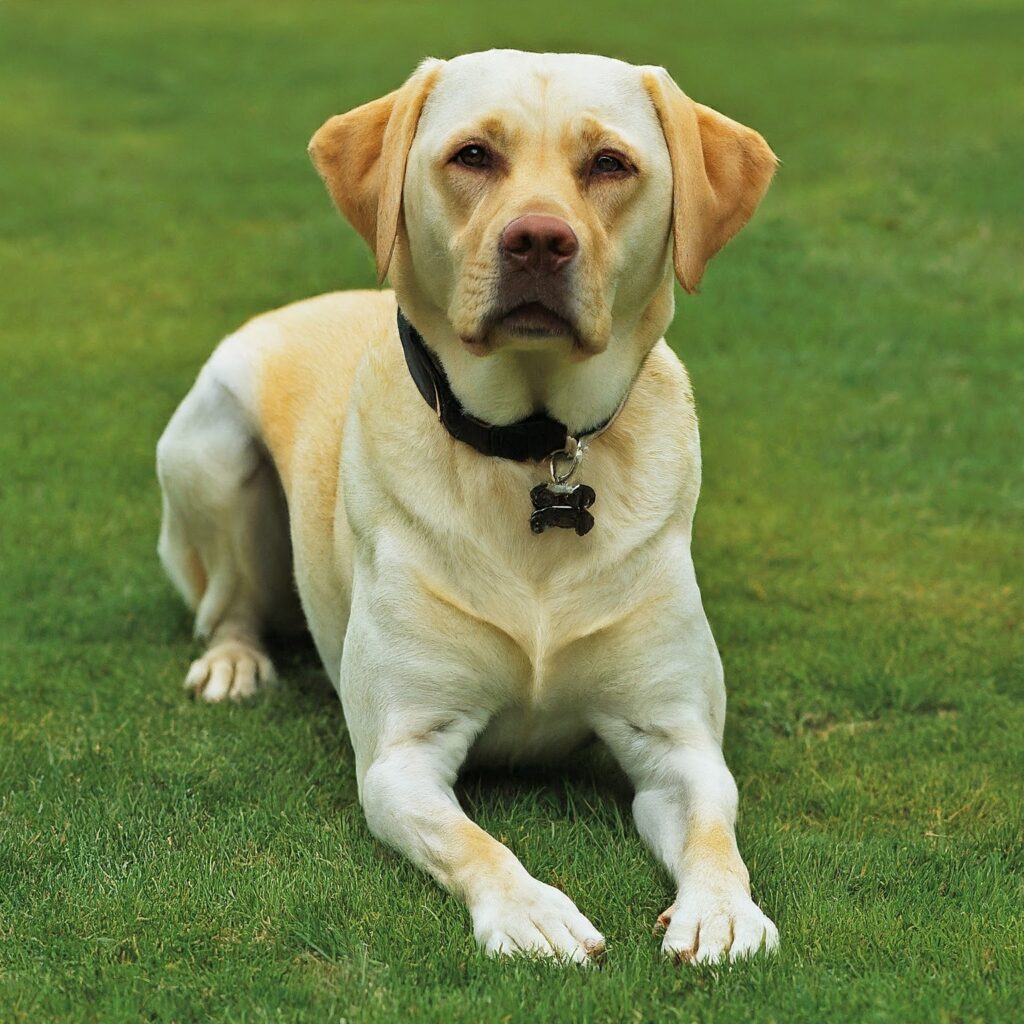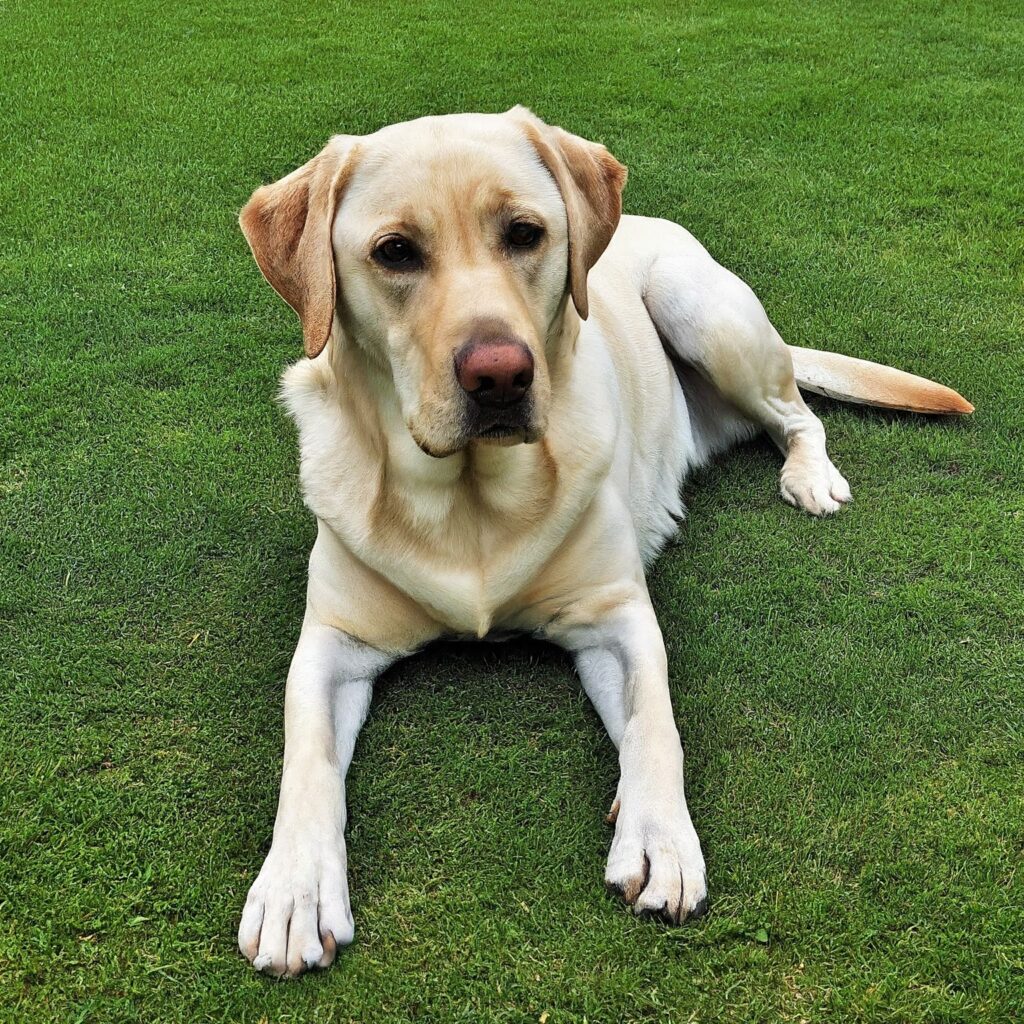Labrador Retriever Muzzles: The Need for a Muzzle
Muzzles, often misunderstood, serve crucial roles in ensuring the safety and comfort of Labrador Retrievers under various circumstances.
These devices, designed specifically for dogs, are not instruments of punishment but protective gear that can help prevent accidents during potentially stressful situations.
Purpose and Function
A muzzle fits over a Labrador’s snout to prevent biting and unwanted chewing. Its primary function is safety. A muzzle can keep the dog and the handler secure during grooming or veterinary visits.
However, the muzzle must fit comfortably. A well-fitting muzzle allows the dog to breathe and pant normally, which is particularly important for Labradors, a breed known for its active and often boisterous behavior.
Best Labrador Retriever Muzzles
| Image | Price | Buy | Title |
|---|---|---|---|
 TopTopTopTop TopTopTopTop | Buy Now | BASKERVILLE ULTRA MUZZLE - Patented Humane Design, Breathable, Dog can Pant and Drink, Adjustable, Padded, Training Muzzle for Medium-sized Dogs, Prevents Biting, Wildlife Scavenging (Size 3, Black) | |
 Top Top | Buy Now | Mayerzon Dog Muzzle, Soft Mesh Covered Muzzles for Small Medium Large Dogs, Poisoned Bait Protection Muzzle with Adjustable Straps, Prevent Biting Chewing and Licking | |
 Top Top | Buy Now | HEELE Dog Muzzle,Soft Nylon Muzzle Anti Biting Barking Chewing,Air Mesh Breathable Drinkable Adjustable Loop Pets Muzzle for Small Medium Large Dogs 4 Colors 4 Sizes | |
 | Buy Now | Crazy Felix Dog Muzzle, Soft Mesh Muzzle for Small Medium Large Dogs Labrador German Shepherd, Breathable Adjustable Muzzles for Biting, Chewing, and Scavenging, Allows Panting and Drinking(Balck, L) | |
 Top Top | Buy Now | BARKLESS Dog Muzzle, Basket Muzzle for Biting, Chewing and Scavenging, Humane Cage Mouth Cover, Perfect for Grooming and Training Medium, Large Aggressive Reactive Dogs | |
 | Buy Now | Mayerzon Dog Muzzle, Basket Muzzle for Small Medium Large Sized Dogs, Muzzle for Dogs to Prevent Biting for Grooming Scavenging, Breathable Muzzle for Husky Golden Retriever Labrador Beagle | |
 Top Top | Buy Now | Dog Muzzle, Soft Air Mesh Muzzle for Small Medium Large Dogs Anti Biting Barking Chewing, Breathable Drinkable Adjustable Loop Pets Muzzle for German Shepherd Husky Labrador Retriever (Black, L) | |
 Top Top | Buy Now | Coppthinktu Dog Muzzle Suit, 7PCS Dog Muzzles for Biting Barking Chewing, Adjustable Dog Mouth Cover for Small Medium Large Dogs, Soft Comfortable Dog Muzzle for Long Snout |
As an Amazon Associate, we earn from qualifying purchases.
Comfort and Safety
The muzzle design should ensure it does not press painfully against the dog’s face. Many muzzles have padding to cushion the snout and straps that adjust without pinching the skin.
A specially designed muzzle that accommodates Labradors’ unique head structure is crucial for Them, as their heads are broader than many other breeds. This ensures that the muzzle remains secure without causing discomfort, allowing for longer periods of use when necessary.
Situational Necessity
Muzzles are particularly useful when a Labrador feels overwhelmed or anxious. New environments, crowded places, or the introduction of new pets can trigger unexpected reactions. A muzzle can prevent a nervous Labrador from snapping at other animals or people.
A muzzle can be invaluable during medical emergencies. Even the gentlest dog might bite when in pain or distress. A muzzle protects the pet and the medical staff, facilitating safer handling and treatment.

Types of Muzzles for Labrador Retrievers
With their friendly nature and strong build, Labrador Retrievers require specific types of muzzles that cater to their size, comfort, and situation. Various muzzle types offer different benefits and drawbacks, so choosing the right one for your Labrador is crucial.
Soft Muzzles
Soft muzzles, made from flexible materials like nylon or soft leather, fit snugly around the dog’s snout. These muzzles are lightweight and less intimidating for the dog, making them ideal for quick uses like vet visits or grooming.
However, because they restrict the mouth from opening, they are unsuitable for long periods as they prevent the dog from panting, drinking, or eating.
Basket Muzzles
Basket muzzles are the most recommended type for Labradors due to their robust design. These muzzles are typically made from wire, plastic, or rubber, allowing more room for the dog’s mouth to open.
This design lets the dog pant, drink, and even eat small treats, which is essential for comfort, especially in warmer weather or during physical activity. The sturdy structure also provides secure protection in various scenarios, from park walks to encounters with new animals.
Leather Muzzle
Leather muzzles are durable and provide a more traditional look. They are often crafted to fit snugly and can be more comfortable due to the softness of the material, which molds to the dog’s face over time.
Leather muzzles are suitable for general use but might not offer as much ventilation as basket muzzles, making them less ideal for intense activities.
Wire Cage Muzzle
Wire cage muzzles offer excellent durability and ventilation. They are often used for training or when a dog needs to wear a muzzle for longer periods.
The open design ensures that the Labrador can pant and drink water easily, making them a good choice for high-energy activities. However, they can be heavier than other types, which might require some getting used to by the dog.
Biothane Muzzle
Biothane muzzles are a modern option, made from a strong, waterproof material that mimics leather in durability but is lighter and easier to clean.
These muzzles are becoming popular for their comfort and the variety of colors they come in. Suitable for short and long durations, they balance soft muzzles’ flexibility and basket muzzles’ robustness.
Choosing the right muzzle for your Labrador involves considering the dog’s comfort, the muzzle’s purpose, and how long the dog will need to wear it. Each type has its place depending on your Labrador’s needs, whether for a quick vet trip or ongoing training and socialization.

Sizing a Muzzle for a Labrador Retriever
Properly fitting a muzzle is essential for ensuring the comfort and effectiveness of the muzzle on a Labrador Retriever. An ill-fitting muzzle can lead to discomfort and even injuries, whereas a well-fitted muzzle will be secure without causing distress to the dog.
Importance of Proper Fit
A correctly sized muzzle allows a Labrador to breathe, pant, and drink water with minimal obstruction, which is crucial for their well-being, especially during stressful situations or extended wear. It should fit snugly enough to stay secure but not so tight that it rubs against the dog’s skin or squeezes its snout.
How to Measure a Labrador Retriever for a Muzzle
Accurate measurements are the foundation of selecting the right muzzle size for a Labrador. Below are the steps to take precise measurements:
Step 1: Measure Neck Circumference
Use a flexible measuring tape around the thickest part of your dog’s neck, typically right below where the neck connects with the head. This ensures the muzzle’s strap will fit comfortably.
Step 2: Measure Snout Circumference
Place the measuring tape about half an inch from the base of the dog’s snout and measure the circumference. Ensure the tape is not too loose or too tight. This measurement is crucial for determining the primary size of the muzzle.
Step 3: Measure Nose to Eye Line
Measure the length from the tip of the nose to the eye line (right below the eyes), which will help determine the muzzle length needed to allow for proper visibility and breathing space.
Step 4: Measure the Neck Behind the Ears
Measure around the neck directly behind the ears. This part of the neck is narrower and ensures the muzzle will not slip off when the dog moves its head.

Choosing the Right Size Muzzle
Once you have these measurements, compare them to the sizing chart provided by the muzzle manufacturer. Each brand may vary slightly in size, so it’s important to check the specific sizing guide for the muzzle you are considering.
If your Labrador’s measurements fall between two sizes, it’s generally safer to choose the larger size and adjust for a snug fit.
Ensuring that the muzzle fits correctly is as crucial for the safety of others as it is for the comfort and health of your Labrador Retriever. A well-fitted muzzle will be secure enough to prevent biting or unwanted chewing but comfortable enough that the dog can wear it without distress.
Popular Muzzle Brands for Labrador Retrievers
Selecting the right muzzle for a Labrador Retriever involves choosing a brand that specializes in quality, comfort, and functionality. Below are some of the most popular brands that cater specifically to the needs of Labradors, ensuring that your dog is comfortable and safe.
Baskerville
Known for their ultra-strong rubber construction, Baskerville muzzles are tough yet flexible. The basket design allows dogs to pant, drink, and even eat while being muzzled, making them ideal for extended wear during activities like walking or training sessions.

Dean & Tyler
Dean & Tyler offers a variety of muzzle designs, including leather and wire cage options. Their muzzles are known for durability and comfort, with many models featuring soft padding to prevent chafing and ensure a snug fit without discomfort.
CollarDirect
CollarDirect specializes in handcrafted leather muzzles for durability and style. Their muzzles are designed to be breathable and comfortable, making them a good choice for dogs that need a muzzle during social situations or as part of a training regimen.
Canine Friendly
Canine Friendly focuses on soft muzzles that are ideal for vet visits or grooming. These muzzles are made from durable nylon and designed to be comfortable for short-term wear. They ensure that the dog can breathe and vocalize but cannot bite.
PetSafe
PetSafe offers a range of muzzles, including adjustable styles for dogs of all sizes. Their products ensure safety and comfort with features like quick-release buckles for easy use.
When choosing a muzzle for your Labrador, consider the specific situations in which it will be used. Whether you need a sturdy option for training or a soft muzzle for quick trips, these brands provide a variety of choices to suit different needs.
Ensure the selected muzzle fits your dog correctly and allows for adequate ventilation, especially if worn for prolonged periods.
Where to Buy Labrador Retriever Muzzles
Muzzles for Labrador Retrievers can be purchased from a variety of outlets, each offering different brands and types:
- Pet Stores: Local pet stores often carry a range of dog muzzles. Shopping in-store lets you see and touch the products, potentially even trying them on your dog for fit.
- Online Retailers: Websites like Amazon, Chewy, and Petco offer many muzzles. Online shopping provides access to customer reviews and often a wider range of products.
- Specialty Dog Supply Shops: These shops may offer more specialized options and higher-quality muzzles for specific needs or behaviors.
- Veterinary Offices: Some vets carry muzzles they recommend for safety during visits or behavioral training.
Considerations for Buying a Muzzle
When purchasing a muzzle for your Labrador, several important factors should be taken into account:
- Material: Choose a material that suits your dog’s needs; soft muzzles are good for short uses, while more durable materials like leather or rubber are better for regular or long-term use.
- Size and Fit: Ensure the muzzle fits properly. It should be snug enough to stay securely in place but not so tight that it restricts your dog’s ability to breathe or pant.
- Purpose: Consider why your dog needs a muzzle. For dogs that need to wear one for extended periods, ensure the muzzle allows for drinking and panting. A simpler design may suffice for brief periods, such as vet visits.
- Comfort: Look for features that increase comfort, such as padding around the edges of the muzzle to prevent rubbing and irritation.
- Adjustability: Adjustable straps can help achieve a better fit, especially as your dog grows or changes in size.
Selecting the right muzzle involves more than just buying; it requires careful consideration of what will provide the best balance of safety, comfort, and practicality for your Labrador Retriever.

Training a Labrador Retriever to Wear a Muzzle
Training your Labrador Retriever to wear a muzzle comfortably ensures your pet’s and others’ safety and well-being. The process should be gradual and filled with positive reinforcement, helping your dog associate the muzzle with positive experiences.
Step 1: Introduction to the Muzzle
Start by letting your Labrador sniff the muzzle. Place treats around and inside it to encourage interaction without forcing the muzzle onto your dog. This step aims to build curiosity and positive associations.
Step 2: Touching the Muzzle
Once your Labrador is comfortable approaching the muzzle, begin touching their nose with it. Use a command like “muzzle” each time you do this. Reward them with treats and praise for calm behavior and gradual acceptance of the muzzle’s touch.
Step 3: Placing the Muzzle
Progress to gently placing the muzzle onto your dog’s snout for a few seconds. Do not fasten it yet. Reward with treats and praise. Gradually increase the time the muzzle is held in place. Ensure this experience remains positive.
Step 4: Fastening the Muzzle
When your Labrador seems comfortable with the muzzle on their snout, begin fastening it for short periods. Continue using treats and praise to maintain a positive association. Start with short durations, like 30 seconds, and slowly increase the time as your dog adjusts.
Step 5: Increasing Wear Time
Gradually extend the duration your Labrador wears the muzzle. Start walking them around the house with the muzzle on, then move to short outdoor trips. Keep rewarding them periodically to reinforce the positive experience.
Step 6: Regular Practice
Incorporate the muzzle into routine activities to normalize its use. Use it during walks, trips to the park, or vet visits. Consistent practice will help cement the muzzle as a normal part of your dog’s life.
Importance of Positive Reinforcement
Positive reinforcement is essential throughout the training process. Treats, praise, and favorite activities can help your Labrador accept the muzzle without stress. The goal is to ensure your dog feels safe and secure, not punished.
Following these steps, you can effectively train your Labrador Retriever to wear a muzzle comfortably. The process requires patience and consistency, but with the right approach, your dog will learn to accept the muzzle as a part of their routine, ensuring safety for everyone involved.
Safety Precautions When Using Muzzles
Using a muzzle on a Labrador Retriever involves more than choosing the right type and fit. Certain safety precautions must be followed to ensure the muzzle serves its purpose without harming the dog or compromising its well-being.
Never Leave a Muzzled Dog Unattended
One of the most important rules for using muzzles is never leaving your Labrador Retriever unattended while muzzled.
This precaution prevents the dog from potentially harming itself in an attempt to remove the muzzle or from being unable to respond to a distressing situation, such as choking or overheating, which it might not be able to signal while muzzling.
Ensure the Dog Can Pant and Drink
The muzzle you choose must allow your Labrador to pant and drink. Panting is a dog’s primary means of cooling down, and being unable to pant, especially in warm environments or during exercise, can lead to overheating and heatstroke. Additionally, the muzzle should allow the dog to drink water freely to prevent dehydration.
Check the Fit Regularly
Regularly check the muzzle fit, especially if your Labrador is still growing or has changed weight. A too-tight muzzle can cause discomfort or injuries, such as chafing or restricted breathing. Conversely, a too-loose muzzle could slip off, rendering it ineffective.
Gradual Acclimatization
Before using a muzzle in public or for extended periods, it’s important to gradually acclimatize your Labrador to wearing it. This involves slowly increasing the time the dog wears the muzzle at home, ensuring they are comfortable and perform necessary functions like yawning, panting, and drinking.
Regular Inspection and Maintenance
Inspect the muzzle regularly for signs of wear and tear. A damaged muzzle can break, potentially allowing the dog to bite, or it could injure the dog. Regular maintenance ensures the muzzle remains safe and effective.
Use Only When Necessary
Finally, use a muzzle only when necessary. While muzzles can be an important safety tool for vet visits, grooming, or public transport, they are not for continuous use. Using a muzzle for behavioral problems should be done under the guidance of a professional trainer.
By following these safety precautions, you can responsibly use a muzzle on your Labrador Retriever, ensuring their safety and the safety of others around them.

Veterinary Perspective on Muzzling Labrador Retrievers
Veterinarians provide key insights into the responsible use of dog muzzles, particularly focusing on behavioral management and the specific needs of different breeds, including those that are not short-faced or brachycephalic, like Labrador Retrievers.
Use of Muzzles for Behavioral Reasons
Veterinarians often recommend muzzles as a temporary solution for managing aggressive behavior in dogs. The goal is to ensure safety while implementing a long-term solution, usually behavioral training.
For Labrador Retrievers, known for their generally friendly nature, a muzzle may be necessary when they exhibit unexpected aggression or anxiety that could lead to biting. This is typically seen in vet visits, grooming sessions, or introducing the dog to unfamiliar environments.
Safety and Comfort
Veterinarians stress the importance of choosing a muzzle that allows the dog to breathe, pant, and drink water freely. This is crucial for maintaining the dog’s well-being, particularly during stress or physical exertion. The muzzle should fit properly to avoid discomfort or injury, with regular checks to adjust the fit as needed.
Considerations for Non-Brachycephalic Breeds
While Labradors are not brachycephalic (short-faced), the considerations for using muzzles on them are somewhat similar to those for brachycephalic breeds to ensure adequate ventilation and comfort.
However, because Labradors typically have longer snouts, a greater variety of muzzle designs can comfortably fit them without restricting breathing.
Training and Positive Reinforcement
Veterinarians advocate using positive reinforcement as part of the training process to acclimate a dog to a muzzle. This approach helps the dog associate the muzzle with positive experiences, thereby reducing stress and making its use more manageable for both the dog and the owner.
Professional Guidance Recommended
Veterinarians recommend consulting a professional dog trainer or a veterinary behaviorist for behavioral issues. A muzzle should not be seen as a solution to behavioral problems but rather as a tool to manage situations safely while seeking a more permanent solution.
Professional guidance ensures a muzzle is properly integrated into a broader behavioral management strategy.
In conclusion, while muzzles can temporarily manage certain behaviors, they are not a substitute for proper training and should be used responsibly under the guidance of professionals.
Proper fit, training to accept the muzzle, and regular monitoring are essential to ensure the health and comfort of Labrador Retrievers when muzzled.
Common Mistakes When Using Muzzles
Using a muzzle on a Labrador Retriever can be a helpful management tool in certain situations. Still, it’s important to avoid common mistakes to ensure the safety and well-being of your dog.
Choosing the Wrong Size
One of the most frequent errors is selecting a muzzle that does not fit properly. A too-tight muzzle can cause discomfort, restrict breathing, or even injure the dog. Conversely, a too-loose muzzle may not effectively prevent biting and could slip off, posing a risk to safety.
Leaving the Muzzle On for Too Long
Muzzles are designed for short-term use. Leaving a muzzle on a Labrador Retriever for an extended period can lead to discomfort, stress, and potential health issues such as overheating or difficulty breathing. It’s crucial to monitor the time your dog spends muzzling.
Using a Muzzle as a Punishment Tool
Another common mistake is using the muzzle as a form of punishment. This approach can lead to negative associations with the muzzle, making your dog more anxious or aggressive. Instead, muzzles should be used positively and controlled as part of a broader behavioral management strategy.
Dos and Don’ts of Using a Muzzle on a Labrador Retriever
Dos:
- Ensure a proper fit: Make sure the muzzle fits snugly without causing discomfort. There should be enough space for your dog to pant and drink water.
- Use positive reinforcement: Help your dog associate the muzzle with positive experiences by using treats and praise during training.
- Monitor your dog closely: While wearing a muzzle, keep a close eye on them to ensure they are comfortable and safe.
Don’ts:
- Don’t leave your dog muzzled and unattended. Always supervise your dog when wearing a muzzle and respond quickly if it becomes distressed or needs adjusting.
- Don’t use the muzzle for too long: Limit the muzzle to the necessary duration for the specific situation to avoid undue stress or discomfort.
- Don’t use the muzzle as a substitute for training: While a muzzle can temporarily manage behavior, it should not replace proper training and socialization needed to address underlying behavioral issues.
By avoiding these common mistakes and adhering to these dos and don’ts, you can use a muzzle effectively and humanely, ensuring it serves as a helpful tool rather than a source of stress for your Labrador Retriever.

Case Studies: Labrador Retrievers Successfully Trained to Wear a Muzzle
Training a Labrador Retriever to wear a muzzle involves patience, consistency, and the right approach to ensure success. Here, we explore real-life stories highlighting effective training methods and positive outcomes.
Case Study 1: Max, the Anxious Labrador
Background: Max was a three-year-old Labrador known for anxiety during vet visits. His owners decided to introduce a muzzle as a precautionary measure.
Training Method: Max’s owners used positive reinforcement to acclimate him to the muzzle. They started by allowing Max to sniff the muzzle and placing treats around it to create a positive association.
Process: They gradually progressed to touching Max’s nose with the muzzle and then placing it over his snout for short periods, always rewarding him with treats and praise.
Outcome: After several weeks, Max could wear the muzzle during entire vet visits without stress. His anxiety levels decreased significantly, and vet visits became more manageable for everyone involved.
Case Study 2: Bella, the Labrador with a Biting Habit
Background: Bella was adopted from a shelter where she developed a biting habit due to past trauma.
Training Method: Bella’s new owner enlisted the help of a professional dog trainer who specialized in behavior modification. The trainer introduced a basket muzzle to ensure safety during training sessions.
Process: The trainer incorporated the muzzle into Bella’s daily routine, using it during walks and training sessions. The training included commands like “muzzle on” and “muzzle off,” rewarding Bella with high-value treats for compliance and calm behavior.
Outcome: Over time, Bella’s aggressive tendencies diminished. She learned to associate the muzzle with positive experiences, like walks and personal attention, which changed her behavior significantly. Bella became more friendly and less reactive to other dogs and people.
Case Study 3: Oliver, the Playful Pup
Background: Oliver was a young Labrador whose playful nature often led to accidental nipping during play.
Training Method: Oliver’s family used a soft muzzle to prevent nipping and taught him gentle play manners through positive reinforcement.
Process: Training sessions focused on rewarding Oliver for calm play and introducing the muzzle for short periods during playtime. Treats were used to encourage him to view the muzzle as a positive tool rather than a restriction.
Outcome: Oliver quickly adapted to wearing the muzzle during play, curtailing his nipping habit. The family continued to use the muzzle as a training aid while reinforcing good behavior with or without it.
These case studies demonstrate that with thoughtful training and a positive approach, Labrador Retrievers can be successfully trained to wear muzzles, leading to safer interactions and improved behavior.
Each story underscores the importance of understanding the dog’s needs and adapting the training accordingly.















